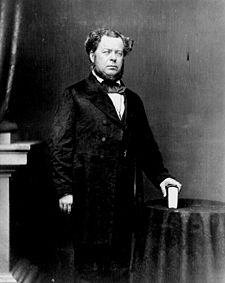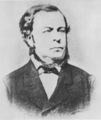Difference between revisions of "Stephen Russell Mallory"
m (+ cat) |
(Add new sig image) |
||
| (One intermediate revision by the same user not shown) | |||
| Line 13: | Line 13: | ||
| parents =Charles and Ellen Russell Mallory | | parents =Charles and Ellen Russell Mallory | ||
| children =Margaret Mallory<br/>Ellen Josephine Mallory<br/>Francis Moreno Mallory<br/>Francis Moreno Mallory (II)<br/>Stephen Russell Mallory, Jr.<br/>Charles Albert Mallory<br/>Atilla Fitzpatrick Mallory<br/>Ruby Angela Mallory<br/>Nellie Mallory | | children =Margaret Mallory<br/>Ellen Josephine Mallory<br/>Francis Moreno Mallory<br/>Francis Moreno Mallory (II)<br/>Stephen Russell Mallory, Jr.<br/>Charles Albert Mallory<br/>Atilla Fitzpatrick Mallory<br/>Ruby Angela Mallory<br/>Nellie Mallory | ||
| + | |signature = MallorySignature.png | ||
| + | |signaturesize = 170px | ||
}} | }} | ||
| − | '''Stephen Russell Mallory''' ([[ | + | '''Stephen Russell Mallory''' ([[1812]] – [[November 9]], [[1873]]) was a United States politician and the Confederate Secretary of the Navy during the American Civil War. Mallory was considered one of President Jefferson Davis's ablest Cabinet officers. He was the father of [[Stephen Mallory II]], a U.S. Representative and Senator from Florida. |
==Early life and career== | ==Early life and career== | ||
| Line 41: | Line 43: | ||
Image:Srmallory2.jpg | Image:Srmallory2.jpg | ||
Image:Srmallory3.jpg | Image:Srmallory3.jpg | ||
| − | |||
</gallery> | </gallery> | ||
Latest revision as of 21:49, 3 November 2008
| Stephen Russell Mallory | |
|---|---|
| Born | 1812 Port of Spain, Trinidad |
| Died | November 9, 1873 Pensacola |
| Occupation | Confederate Secretary of the Navy, politician, lawyer |
| Spouse | Angela Moreno |
| Parents | Charles and Ellen Russell Mallory |
| Children | Margaret Mallory Ellen Josephine Mallory Francis Moreno Mallory Francis Moreno Mallory (II) Stephen Russell Mallory, Jr. Charles Albert Mallory Atilla Fitzpatrick Mallory Ruby Angela Mallory Nellie Mallory |
Stephen Russell Mallory (1812 – November 9, 1873) was a United States politician and the Confederate Secretary of the Navy during the American Civil War. Mallory was considered one of President Jefferson Davis's ablest Cabinet officers. He was the father of Stephen Mallory II, a U.S. Representative and Senator from Florida.
Contents
Early life and career[edit]
Mallory was born in Trinidad, British West Indies, sometime about the year 1812 (sources vary). However, his father died when he was just two years old, and his family brought him to the United States in 1820. His mother opened a boarding house in Key West. He was educated in Mobile, Alabama at Spring Hill College, and Nazareth, Pennsylvania. With little education, he still managed to open a law office, and held various governmental positions in the Key West area. After marrying the Angela Moreno, daughter of a wealthy Pensacola family, he was elected to the United States Senate as a moderate Democrat in 1850, serving through 1857.
He had a reputation as one of the most knowledgeable men in Alabama about naval affairs; therefore, he was appointed chair of the Senate Committee on Naval Affairs. He worked tirelessly to reform the United States Navy, helping to retire elderly and ineffective officers, and vouched for the development of an iron-encased floating battery (possibly the precursor to the ironclad warship), but failed to secure funding to complete the project.
Civil War[edit]
After the 1860 Election of Abraham Lincoln, Mallory urged conciliation (as did many other eventual prominent Southern politicians, including Jefferson Davis). However, like many others, his loyalties lay with the South, and when Florida seceded, he followed. Because of his friendship with President Davis, the need of a Floridian cabinet member, and his extremely useful and vast knowledge of naval affairs, he was appointed Secretary of the Navy.
At the start of the war, though, the Confederacy barely owned fifteen warships and very few naval officers had seceded. Also, the Confederate War Department did not cooperate very efficiently, and naval funding was very limited. However, Mallory was somewhat effective in finding some European ships, mainly from Great Britain. Arguably his most important British acquisition was the C.S.S. Alabama, which was captained by Raphael Semmes, and was arguably the most famous Confederate raider. These raiders would mainly be used to attack merchant shipping, possibly diverting some blockade ships and ruining the Union blockade (which was slowly choking the South). Also, his vision of creating many ironclad warships to destroy the mainly wooden warships of the Union blockades was not fulfilled, mainly because of the main Southern disadvantage: a lack of funds and materiel. In a related sense, his most important "failure" was not being able to persuade the other government officials to allot enough funding toward the navy.
Also, Mallory was extremely innovative. Even though the Southern industrial plants did not even rival the Northern plants, and added by the loss of Nashville, New Orleans, Memphis, and Norfolk in the early war (these being important plants and ports), the C.S. Navy was able to produce 22 ironclads during the war, an ingenious accomplishment. Also, experimental weapons and tactics were explored, including torpedoes, submarines, and secret amphibious raids, although these were generally ineffective.
Postbellum[edit]
However, after General Robert E. Lee evacuated Petersburg, Virginia, which meant the loss of the capital and seat of government, Richmond, Mallory (along with the remainder of the cabinet) was forced to flee. After defeat was certain, he opposed guerrilla warfare in the latter days of the war. He was imprisoned at Fort Lafayette, New York for approximately ten months, before being released.
He moved back to his law practice, while opposing the use of the military in Reconstruction and opposing black suffrage. He died in 1873, with his contemporaries partly blaming him for the Confederate defeat. Historians are much more complimentary of Mallory than his own contemporaries, realizing that persuading the other, more land-oriented members of the Confederate government into allotting badly-needed funds to a navy that was almost certainly defeated from the start was almost impossible, even for the most persuasive politician.
Remembered in Pensacola[edit]

Mallory is honored with a street in Pensacola, and Lee Square is partly dedicated to him. He is buried at St. Michael's Cemetery.
Other images[edit]
External links[edit]
| Preceded by: David L. Yulee |
United States Senator (Class 1) from Florida 1851–1861 |
Succeeded by: vacant[1] |
| Preceded by: (none) |
Confederate States Secretary of Navy 1861 – 1865 |
Succeeded by: (none) |
- ↑ Note: Florida seceded from the Union in 1861. Seat was declared vacant until Adonijah Welch was elected after Florida's readmission into the Union in 1868.





